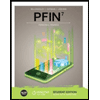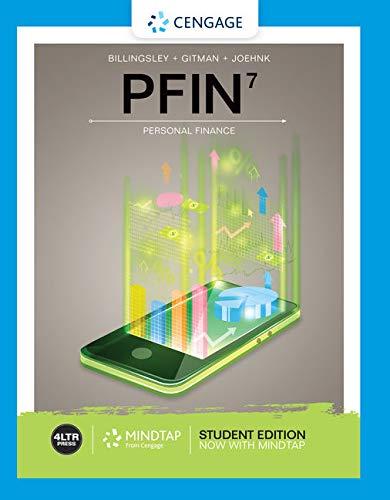
Pfin (with Mindtap, 1 Term Printed Access Card) (mindtap Course List)
7th Edition
ISBN: 9780357033609
Author: Randall Billingsley, Lawrence J. Gitman, Michael D. Joehnk
Publisher: Cengage Learning
expand_more
expand_more
format_list_bulleted
Concept explainers
Question
Chapter 6, Problem 1LO
Summary Introduction
To determine: The reason behind the usage of consumer credit and lay down the benefits and problems associated with it.
Expert Solution & Answer
Explanation of Solution
The major reasons for which the consumer credit is used by the individuals are as follows:
- In order to make the purchases of expensive items without investing the huge amount at the single point of time.
- In order to meet the requirements at the time of emergency such as meting living expenses in the time of job loss or for paying the visit in the time of emergency.
- To pay the bills of various outlets or to pay the fees of various services from the place of convenience.
- Investments policies are purchased by using the funds from the consumer credit by many individuals.
Benefits of using the consumer credit are as follows:
- Helps to purchase the expensive items like car, furniture without disturbing the cash budget of the individuals.
- Easy availability of funds at the time of emergency.
Problems associated with the usage of consumer credit are as follows:
- Higher interest rates to be paid by the borrower on the borrowed amounts.
- Overspending the credit amount will become a debt trap which may lead into bankruptcy, poor credit ratings or the lawsuits.
Want to see more full solutions like this?
Subscribe now to access step-by-step solutions to millions of textbook problems written by subject matter experts!
Students have asked these similar questions
Diversification is a strategy used to:A. Increase total riskB. Eliminate systematic riskC. Increase expected returnsD. Reduce unsystematic riski need help!!
Diversification is a strategy used to:A. Increase total riskB. Eliminate systematic riskC. Increase expected returnsD. Reduce unsystematic risk
I need answer !!
What is the effect of compounding interest?A. It decreases total interest earned over timeB. It keeps the interest constantC. It increases interest earned over time by earning interest on interestD. It applies only to loans, not investments
Chapter 6 Solutions
Pfin (with Mindtap, 1 Term Printed Access Card) (mindtap Course List)
Knowledge Booster
Learn more about
Need a deep-dive on the concept behind this application? Look no further. Learn more about this topic, finance and related others by exploring similar questions and additional content below.Similar questions
- What is the effect of compounding interest?A. It decreases total interest earned over timeB. It keeps the interest constantC. It increases interest earned over time by earning interest on interestD. It applies only to loans, not investmentsarrow_forwardWhat is the effect of compounding interest?A. It decreases total interest earned over timeB. It keeps the interest constantC. It increases interest earned over time by earning interest on interestD. It applies only to loans, not investments need answer !!arrow_forwardi need help in this question!What is the primary goal of corporate finance?A. Maximize salesB. Minimize costsC. Maximize shareholder wealthD. Maximize employee satisfactionarrow_forward
- What is the primary goal of corporate finance?A. Maximize salesB. Minimize costsC. Maximize shareholder wealthD. Maximize employee satisfactionhelp me please !arrow_forwardWhat is the primary goal of corporate finance?A. Maximize salesB. Minimize costsC. Maximize shareholder wealthD. Maximize employee satisfactionarrow_forwardWhat does the price-to-earnings (P/E) ratio indicate?a) The total debt of a companyb) The market value relative to earningsc) The return on equityd) The efficiency of company operationshelp in thisarrow_forward
- What does the price-to-earnings (P/E) ratio indicate?a) The total debt of a companyb) The market value relative to earningsc) The return on equityd) The efficiency of company operationsarrow_forwardWhich of the following is an example of equity financing?a) Issuing bondsb) Taking out a bank loanc) Selling shares of stockd) Borrowing from a financial institutionplease answer step by step.arrow_forwardNo ai. Which of the following is an example of equity financing?a) Issuing bondsb) Taking out a bank loanc) Selling shares of stockd) Borrowing from a financial institutionarrow_forward
- Which of the following is an example of equity financing?a) Issuing bondsb) Taking out a bank loanc) Selling shares of stockd) Borrowing from a financial institutionarrow_forwardThe Efficient Market Hypothesis (EMH) suggests that:a) Stock prices are predictableb) The market always prices securities perfectlyc) Investors can consistently beat the marketd) Securities are always overvaluedarrow_forwardThe Efficient Market Hypothesis (EMH) suggests that:a) Stock prices are predictableb) The market always prices securities perfectlyc) Investors can consistently beat the marketd) Securities are always overvaluedhelp me!!arrow_forward
arrow_back_ios
SEE MORE QUESTIONS
arrow_forward_ios
Recommended textbooks for you
 Pfin (with Mindtap, 1 Term Printed Access Card) (...FinanceISBN:9780357033609Author:Randall Billingsley, Lawrence J. Gitman, Michael D. JoehnkPublisher:Cengage Learning
Pfin (with Mindtap, 1 Term Printed Access Card) (...FinanceISBN:9780357033609Author:Randall Billingsley, Lawrence J. Gitman, Michael D. JoehnkPublisher:Cengage Learning

Pfin (with Mindtap, 1 Term Printed Access Card) (...
Finance
ISBN:9780357033609
Author:Randall Billingsley, Lawrence J. Gitman, Michael D. Joehnk
Publisher:Cengage Learning